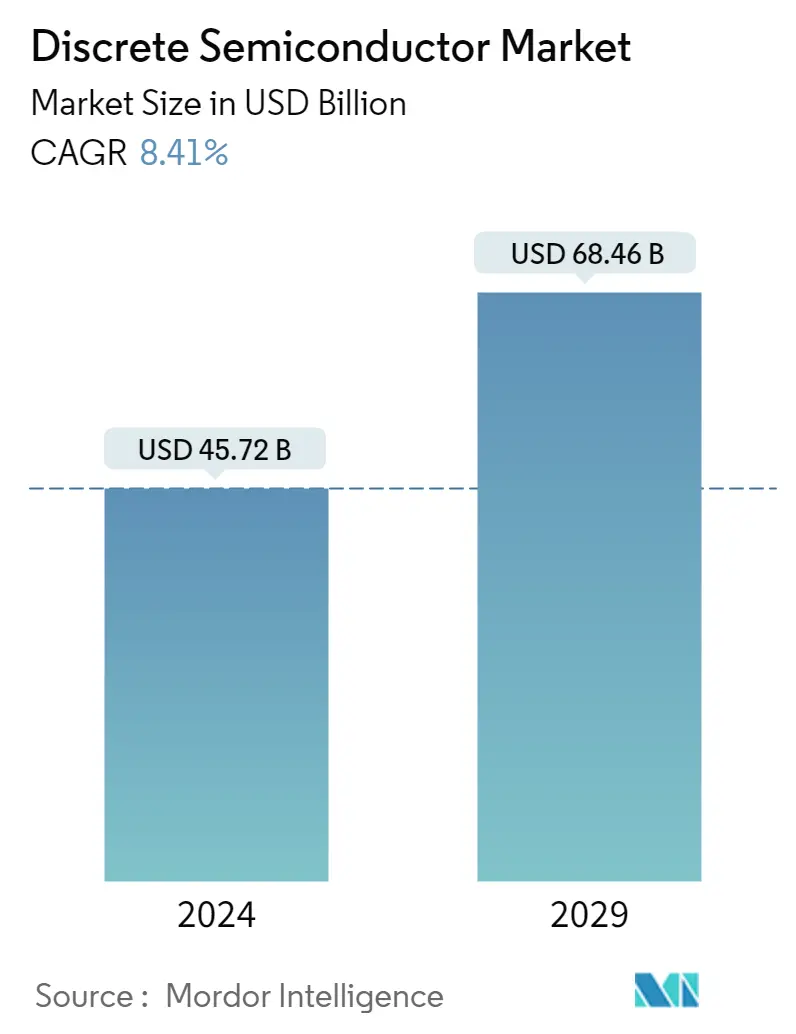Market Size of Discrete Semiconductor Industry

| Study Period | 2019 - 2029 |
| Market Size (2024) | USD 45.72 Billion |
| Market Size (2029) | USD 68.46 Billion |
| CAGR (2024 - 2029) | 8.41 % |
| Fastest Growing Market | Asia Pacific |
| Largest Market | Asia Pacific |
Major Players*Disclaimer: Major Players sorted in no particular order |
Need a report that reflects how COVID-19 has impacted this market and its growth?
Discrete Semiconductor Market Analysis
The Discrete Semiconductor Market size is estimated at USD 45.72 billion in 2024, and is expected to reach USD 68.46 billion by 2029, growing at a CAGR of 8.41% during the forecast period (2024-2029).
The discrete semiconductor market is driven by the increasing need to manage power across electronics and miniaturization. The reduction in package size is inversely proportional to power dissipation. For instance, NXP semiconductors achieved a 55% reduction in packaging size for their transistors range by retaining the same power performance. Additionally, Diodes Incorporated launched 40V-rated DMTH4008LFDFWQ and 60V-rated DMTH6016LFDFWQ automotive-compliant MOSFETs packaged in DFN2020.
- Moreover, characteristics like safety, infotainment, navigation, and fuel efficiency in the automotive components, and security, automation, solid-state lighting, transportation, and energy management in industrial components are expected to fuel the market studied. For instance, an insulated gate bipolar transistor (IGBT) is an integral component in the EV power electronics system. IGBTs are expected to witness significant demand due to increasing sales of EVs globally. As per the IEA report, sales of electric cars globally reached 6.6 million in 2021. Electric cars accounted for 9% of global car sales.
- Commercialization of these electric vehicles is on the rise. Volvo is aiming for 50% of its sales to be made up of fully electric cars by 2025. BMW has also dropped its i5 plans and will now focus on electrification of other series models like the X3 and 4 Series GT. The latter will directly compete with Tesla's Model 3 and Model y.
- Furthermore, companies are developing new solutions in the power module segment to expand their presence and increase market share. For instance, In December 2021, STMicroelectronics, a prominent semiconductor company serving customers across the spectrum of electronics applications, has announced the release of its third generation of STPOWER silicon-carbide (SiC) MOSFETs1, advancing the state-of-the-art in power devices for electric-vehicle (EV) powertrains and other applications where power density, energy efficiency, and reliability are key target criteria.
- In contrast, the COVID-19 outbreak has had an enormous impact on the global and national economies. Many end-user industries have been affected, including discrete semiconductors. A large part of the manufacturing of electronic components includes work on the factory floor, where people are in close contact as they collaborate to boost productivity. Currently, companies in the market are quickly evaluating the impacts on three fronts: market demand, supply chain, and workforce. Demand for the product is shifting across ASICS, memory, sensors, etc., while consumer behavior changes rapidly and with future volatility. Also, many companies have delayed their hardware upgrades and other long-term migration projects. For instance, the rollout of the 5G plan has been delayed in many countries, such as India, Japan, Poland, and Israel, which, in turn, caused uncertainty for the launch of commercial 5G services.
- The global supply chains are disrupted as the virus spreads across the world, as still there is uncertainty over quarantine durations. Many manufacturing factories were shut down across the world to contain the deadly virus. For instance, most of the manufacturing facilities of On Semiconductors were shut down due to government mandates in countries like Malaysia, China, Malaysia, and the Philippines, which impacted its ability to supply products to its clients and created a gap in demand and supply.
